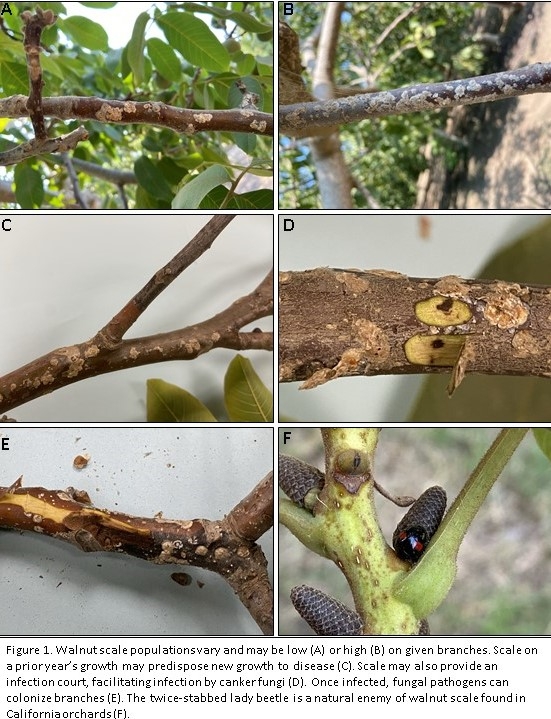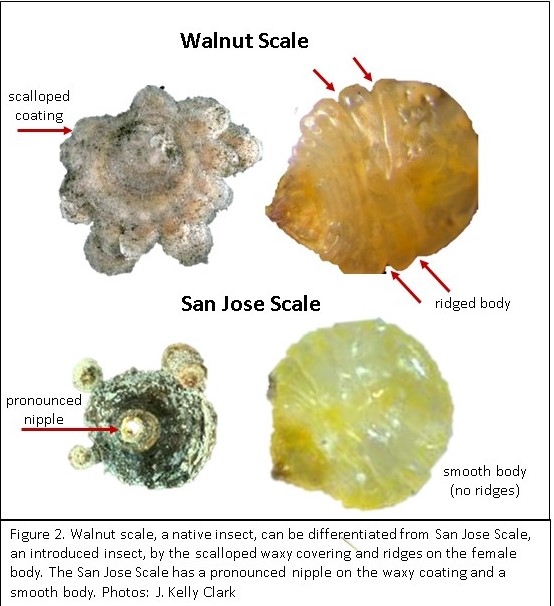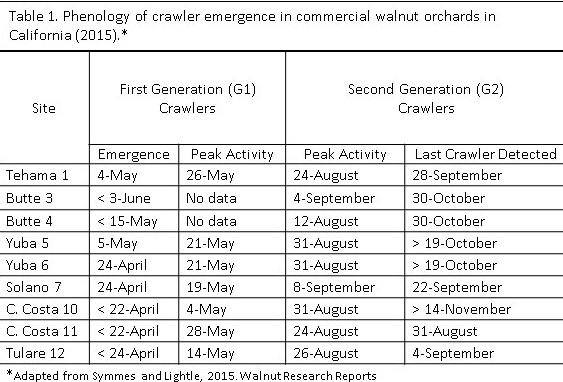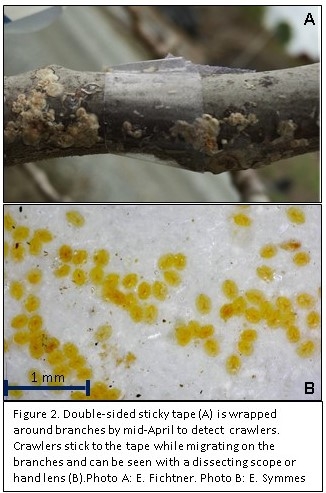Walnut scale (Quadraspidiotus juglansregiae) is a common pest of walnut throughout California's Central Valley. Populations of the pest in commercial walnut orchards (Figure 1 A and B) appear to have increased over the past decade, inciting a recent surge of research on the biology and management of walnut scale. University of California researchers have recently monitored crawler emergence patterns in multiple walnut growing regions, thus improving the phenological models utilized in timing insecticide applications. Other studies have focused on evaluation of insecticide chemistries for management of the pest, including softer insecticide chemistries and insect growth regulators (IGRs). Additionally, walnut scale has been found to interact with canker-causing, plant pathogenic fungi in the canopy, thus exacerbating diseases that may further compromise orchard productivity (Figure 1 C, D and E).
Despite its name, walnut scale is not unique to walnut. It is native to North America and has a wide host range including woody shrubs, deciduous plants, and conifers. In California, walnut scale populations sampled from commercial orchards all represent a single species; however, the population composition of walnut scale across other hosts and regions has not been assessed at a genetic level. In California walnut orchards, walnut scale has historically been considered a minor pest. In the past decade, the insect has transitioned from an orchard inhabitant to a pest as the effective insecticides for walnut scale control have been cancelled.
The causes of walnut scale's recent emergence as a pest are not fully understood. It is speculated that populations of walnut scale are higher than historic levels. The interaction of scale with canker fungi, such as Botryosphaeria spp., may also be a new relationship for walnut scale. These pathogenic fungi have recently emerged as economic pathogens of walnut despite having been previously endemic in California. Generally, disturbances in natural or agricultural ecosystems may induce changes in the roles of ecosystem inhabitants, such as insects, pathogens, weeds, and other microbes. For example, prior to the introduction of DDT and other similar chemical insecticides for the management of codling moth, scale insects were not considered economic pests of walnut orchards in California. Utilization of these insecticides disrupted natural enemies (Figure 1F) of several scale species, resulting in a disruption in the orchard ecosystem and necessitating management of scale populations.
Walnut Scale and Botryosphaeriaceae. Walnut scale predisposes trees to infection by Botryosphaeriaceae fungi both directly and indirectly. A direct association between scale and fungal infection is observed when the scale body is lifted from the shoot to reveal a developing canker (Figure 1D). In this direct interaction between the scale and the pathogen, the feeding activity of the insect likely created an infection court (mode of entry) for the pathogen to infect and colonize the branch (Figure 1E). Infestation of twigs by walnut scale also predisposes new growth to infection and disease development. In this indirect interaction between the insect and the pathogen, the canker develops on plant tissue that remains uncolonized by the insect (Figure 1C). Research studies with three different pathogens in the Botryosphaeriaceae family suggest that disease levels are 60-70% higher on branches colonized by scale than on uncolonized branches.
Walnut Scale Identification. Walnut scale is an armored scale with a scalloped waxy coating (Figure 2). The adult female scale is revealed by lifting the waxy coating. The body of the adult female walnut scale can be differentiated from that of the San Jose Scale (a non-native armored scale) by the ridges on the body. Conversely, the adult female San Jose Scale has a smooth body and a pronounced nipple on the coating (Figure 2).
Walnut Scale Lifecycle. Walnut scale nymphs overwinter in orchards and metamorphose to the adult stage in spring. The females remain non-motile but the adult male is winged and able to fly. After mating, the females lay eggs and the eggs hatch in two to three days and then the crawlers emerge. Crawler emergence is in late April to mid-May in California, depending on the climate and location. For example, initial crawler emergence has been observed as early as mid-late April in Contra Costa andTulare County orchards, and as late as
early May in Tehama County orchards (Table 1).
Female crawlers move around, allowing the scale to colonize the current season's shoots. Once a female crawler finds a place to settle and begin feeding, she secretes the scale cover. Male crawlers migrate to the margins of the female cover and settle. Initially the scale cover is white, but it changes to gray or brown in about a week. The female then goes through two instar stages and the male goes through four instars before maturing to the adult and a second generation is initiated in the same season. Second generation crawlers emerge in late July to early August with crawler populations peaking in late August to early September. Second generation crawler activity is generally complete by the end of October; however, at some sites, crawlers may be active into mid-November. These second-generation crawlers will settle and molt before winter.
Detection of Crawler Emergence. To target insecticide applications to the crawler stage, double-sided sticky tape can be wrapped around walnut scale-infested branches in mid-April (Figure 3A). Emerging crawlers stick to the tape as they navigate to find feeding sites. Tapes should be changed weekly and checked under a magnifying glass to observe crawlers (Figure 3B).
Chemical Control. Walnut scale can be managed with either broad-spectrum insecticides or IGRs. IGRs are a preferable tool for use in an integrated pest management program because they are less disruptive to natural enemies than contact insecticides. IGRs work by disrupting the molting process; therefore, their activity is not realized immediately but rather over time as the insect develops. When applied at the delayed dormant stage (ie. March), IGRs would have the opportunity to inhibit the maturation of the overwintering scale to the adult stage. When applied in late spring (ie. late April-early May), IGRs may impact egg hatch as well as the development of the first-generation nymphs.
IGRs including buprofezin and pyriproxyfen are effective for management of walnut scale. In UC trials, pyriproxyfen was only tested as a delayed dormant application, whereas buprofezin was tested at both at the delayed dormant and the crawler stage timings. In season, the delayed dormant buprofezin application was superior to the crawler application for reducing crawler populations; however, applications of the product at either timing yielded similar suppression of scale populations in the subsequent season. Only one IGR application per year should be adequate for management of the pest. Effective monitoring and decision-support can help determine the need to treat on a yearly basis. For more information, on monitoring visit the Sac Valley Orchards website (https://www.sacvalleyorchards.com/walnuts/insects-mites-walnuts/walnut-dormant-monitoring-and-treatment-decisions/).
Products other than IGRs also exhibit efficacy in walnut scale management. In UC trials, acetamiprid, spirotetramat, and bifenthrin/imidacloprid, when applied at the crawler stage, were effective for scale management. The full impact of both spirotetramat and bifenthrin/imidacloprid were not fully realized until the following season.
Summary. Walnut scale had become an insidious pest in walnut orchards. Orchards with high disease pressure caused by fungi in the Botryosphaeriaceae family will benefit from both management of walnut scale and pathogens. If populations of the scale are high, or appear to have increased recently, it may be time to apply an IGR for scale management. IGRs may offer scale suppression over multiple years and often the efficacy of products may not manifest until successive seasons due to the mode of action.
For more information on walnut scale and other pests and diseases of walnut, visit the UC IPM website (ipm.ucdavis.edu). Research reports from studies conducted with support from the California Walnut Board are posted online (walnutresearch.ucdavis.edu). Mention of any particular chemistries or trade names does not constitute a recommendation and are for informational purposes only. Always consult with your licensed crop consultant and adhere to the pesticide label and local and state regulations. Additionally, check with certifier to determine which products are organically acceptable.
Attached Images:



